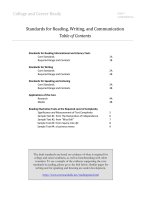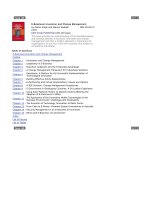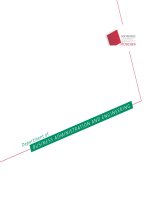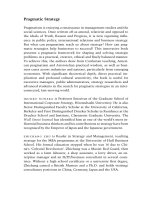Business writing and communication
Bạn đang xem bản rút gọn của tài liệu. Xem và tải ngay bản đầy đủ của tài liệu tại đây (2.72 MB, 256 trang )
“Imagine a one-on-one conversation with a communication guru,
mentoring, modeling, and motivating you to become a more
effective and efficient communicator. You need not imagine,
because that guru, Kenneth Davis, has provided those three Ms
in The McGraw-Hill 36-Hour Course in Business Writing and
Communication, a book that will transform your hope and dreams
for improving your writing into the reality of becoming a better
writer.”
D
R. LYLE SUSSMAN
Professor and Chairman, Department of
Management and Entrepreneurship
College of Business
University of Louisville
Coauthor of Smart Moves, Smart Moves for People in Charge,
What to Say to Get What You Want, Yes You Can,
Close the Deal, and Lost and Found
This page intentionally left blank
New York Chicago San Francisco Lisbon London Madrid Mexico City
Milan New Delhi San Juan Seoul Singapore Sydney Toronto
BU S INE SS
WRITING
AND
C O MMUNI CATI O N
SECOND EDITION
THE
McGRAW-HILL
36-Hour Course
Kenneth W. Davis, Ph.D.
Copyright © 2010 by Kenneth W. Davis. All rights reserved. Except as permitted under the United
States Copyright Act of 1976, no part of this publication may be reproduced or distributed in any form
or by any means, or stored in a database or retrieval system, without the prior written permission of
the publisher.
ISBN: 978-0-07-174394-5
MHID: 0-07-174394-4
The material in this eBook also appears in the print version of this title: ISBN: 978-0-07-173826-2,
MHID: 0-07-173826-6.
All trademarks are trademarks of their respective owners. Rather than put a trademark symbol after
every occurrence of a trademarked name, we use names in an editorial fashion only, and to the
benefit of the trademark owner, with no intention of infringement of the trademark. Where such
designations appear in this book, they have been printed with initial caps.
McGraw-Hill eBooks are available at special quantity discounts to use as premiums and sales
promotions, or for use in corporate training programs. To contact a representative please e-mail us at
TERMS OF USE
This is a copyrighted work and The McGraw-Hill Companies, Inc. (“McGraw-Hill”) and its licensors
reserve all rights in and to the work. Use of this work is subject to these terms. Except as permitted
under the Copyright Act of 1976 and the right to store and retrieve one copy of the work, you may not
decompile, disassemble, reverse engineer, reproduce, modify, create derivative works based upon,
transmit, distribute, disseminate, sell, publish or sublicense the work or any part of it without
McGraw-Hill’s prior consent. You may use the work for your own noncommercial and personal use;
any other use of the work is strictly prohibited. Your right to use the work may be terminated if you
fail to comply with these terms.
THE WORK IS PROVIDED “AS IS.” McGRAW-HILL AND ITS LICENSORS MAKE NO GUAR-
ANTEES OR WARRANTIES AS TO THE ACCURACY, ADEQUACY OR COMPLETENESS OF
OR RESULTS TO BE OBTAINED FROM USING THE WORK, INCLUDING ANY INFORMA-
TION THAT CAN BE ACCESSED THROUGH THE WORK VIA HYPERLINK OR OTHERWISE,
AND EXPRESSLY DISCLAIM ANY WARRANTY, EXPRESS OR IMPLIED, INCLUDING BUT
NOT LIMITED TO IMPLIED WARRANTIES OF MERCHANTABILITY OR FITNESS FOR A
PARTICULAR PURPOSE. McGraw-Hill and its licensors do not warrant or guarantee that the
functions contained in the work will meet your requirements or that its operation will be
uninterrupted or error free. Neither McGraw-Hill nor its licensors shall be liable to you or anyone else
for any inaccuracy, error or omission, regardless of cause, in the work or for any damages resulting
therefrom. McGraw-Hill has no responsibility for the content of any information accessed through the
work. Under no circumstances shall McGraw-Hill and/or its licensors be liable for any indirect,
incidental, special, punitive, consequential or similar damages that result from the use of or inability
to use the work, even if any of them has been advised of the possibility of such damages. This
limitation of liability shall apply to any claim or cause whatsoever whether such claim or cause
arises in contract, tort or otherwise.
To my fellow members of the Association of Professional
Communication Consultants, especially Dan Dieterich,
Lee Clark Johns, and Barbara Shwom
This page intentionally left blank
vii
CONTENTS
Acknowledgments xi
Introduction: Manage Your Writing 1
Be Your Own Communication Department 3
Writing in a Knowledge Economy 8
What a Writing Course Can—and Can’t—Do 12
How to Use This Book 16
“The Discipline of the Craft” 17
Managing Your Writing Time 18
The Law of the Next Action 21
The 12 Steps 23
Manage Your Writing 25
Manage Your Writing Today 26
Chapter 1. Find the “We”: Manage Your Relationship with
You r Reader 27
Communication and Community 30
Personality 32
Attitude 35
Circumstances 38
Knowledge 41
Manage Your Writing Today 45
viii Contents
Chapter 2. Make Holes, Not Drills: Manage with Purpose 47
Death to Subject Lines 50
Ko and Mei Communication 53
The Long and Short of It 54
The Corporate Communication Grid 56
Manage Your Writing Today 61
Chapter 3. Get Your Stuff Together: Manage
You r Information 63
Asking Questions 65
Outside and Inside 68
Map Your Information 70
Manage Your Writing Today 73
Chapter 4. Get Your Ducks in a Row: Manage
Your Structure 75
An Everyday Example 78
The Technique of Organizing 81
Formulas 82
Writing to Sell 87
From Information to Knowledge 90
Manage Your Writing Today 94
Chapter 5. Do It Wrong the First Time: Manage
Your Drafting 97
Draft as Prototype 98
Debriefing the Exercise 101
Overcoming Writer’s Block 102
Writing and “Flow” 103
Manage Your Writing Today 106
Chapter 6. Take a Break and Change Hats: Manage Your
Internal Writer and Editor 109
Breaking for Objectivity 110
From Writer-Based to Reader-Based 113
The Two Hats 115
Manage Your Writing Today 122
Contents ix
Chapter 7. Signal Your Turns: Manage Your Paragraphs 125
Tools for Revision 127
Turn Signals 129
Manage Your Writing Today 140
Chapter 8. Say What You Mean: Manage Your Subjects
and Verbs 143
Hidden Subjects 145
Hidden Verbs 146
Hidden Subjects and Verbs 148
Active or Passive 149
Modifiers 151
Manage Your Writing Today 156
Chapter 9. Pay by the Word: Manage Your
Sentence Economy 159
Objectivity and Common Sense 162
Two Tools 164
Beckwith on Economy 165
Manage Your Writing Today 168
Chapter 10. Translate into English: Manage Your
Word Choices 171
Learning from the IRS 173
Word Histories 176
Good Reasons Otherwise 181
Readability Formulas and Style Checkers 184
Deliberate “Obfuscation”? 186
Three Examples 188
Manage Your Writing Today 192
Chapter 11. Finish the Job: Manage Your Spelling,
Punctuation, and Mechanics 195
Manage Your Writing Today 202
Chapter 12. Manage Your Writing: Evaluate Your
Writing Process 205
Manage Your Writing Today 206
x Contents
Appendix A: Manage Your Online Writing 209
Appendix B: Manage Your Global Writing:
The Case of the Belgian Fries
217
Appendix C: Manage Your Speaking 223
Appendix D: Resources for Managing Your Writing 229
Index 233
xi
ACKNOWLEDGMENTS
F
or making this edition possible, I thank:
• The readers of, and commentors on, my blog at manageyour
writing.com, including Mohammed Al-Taee, Adam Freed-
man, Danielle Ingram, Roy Jacobsen, Delaney Kirk, Norm
Leigh, David William Peace, Dwayne Phillips, Brad Shorr,
Cheryl Stephens, Matthew Stibbe, Raymond P. Ward, and
Joanna Young
• My designer, Dean Eller, of DesignMark, Inc., Indianapo-
lis, Indiana
• My agent, Paul S. Levine
• My team at McGraw-Hill, including Michele Wells, Nancy
Hall, and Alison Shurtz
• Above all, my wife and partner, Bette Davis
This page intentionally left blank
1
INTRODUCTION:
MANAGE YOUR WRITING
I
n this knowledge economy, writing is the chief value-producing
activity. But you may not be writing as well as you could. That
may be because you think writing requires a special talent that
some people have and some people don’t.
In fact, writing is a process that can be managed like any other
business process. If you can manage people, money, or time, then you can
manage your writing. And you can profit from the results.
This book will give you the tools to become—in the next 36 hours—
a more effective, efficient manager of your own writing.
• You’ll become more effective because you’ll learn to produce writing
that gets things done.
• You’ll become more efficient because you’ll learn to produce more
effective writing in less time.
How can this magic happen in just 36 hours? It’ll happen because
you’ll learn to take the management skills you already have and apply
them to the process of writing. Remember, whether or not the word man-
ager is part of your job title, you clearly are a successful manager. Oth-
erwise, you wouldn’t have
2 The McGraw-Hill 36-Hour Course in Business Writing and Communication
• the money to buy this book,
• the position to have somebody else buy it for you,
• or the time and initiative to be browsing through it in a bookstore.
Through your experience in business and in life, you’ve learned to
manage: to manage people, to manage money, to manage time. This book
will teach you how to use these same skills when you write.
Let me tell you a story. When I was a kid growing up in rural Iowa,
there was a local fisherman who had more money than common sense. He
always had the newest, most expensive fishing gear, but he didn’t always
know how to use it.
One fall he decided to take up ice fishing. He ordered the very best
cold-weather clothing, the very best portable shelter, the very best ice
saw and tackle. The first winter day our local reservoir had frozen over
enough, he was out on the ice at dawn. He set up his shelter, sawed his
hole in the ice, sat on his new folding stool, and waited.
Three hours passed without even a sign of a fish. The disgusted
fisherman was about to call it quits and head home when he saw a teen-
age kid in faded blue jeans and a faded green Army field jacket head out
onto the ice. The kid whacked a hole in the ice with a hammer, baited a
hook, and immediately pulled out a nice fish. Within 10 minutes, the kid
had a bucketful and turned back for the shore.
The older man yelled for him, but the kid was apparently out of voice
range. So the man started walking fast toward him and finally caught up
with him at the shore.
“Son,” the man said, “I’ve been out here three hours without catch-
ing a fish, and you’ve pulled out half a dozen in 10 minutes. What’s your
secret?”
“Hmrm hmrm,” the boy muttered.
“What’s that?” asked the man.
“HMRM HMRM,” answered the boy, louder.
“I’m sorry, son; I can’t understand you. What’s your secret?”
The boy moved his hand to his face, took a handful of something
out of his mouth, and explained.
Introduction: Manage Your Writing 3
“WARM WORMS.”
Well, OK, that story didn’t really happen. But I wanted you to
believe, for a while, that it had happened in order to make two points:
1. Writing can change and even create reality. For a while, my words
made that story real for you. And the writing you do on the job
can create a new, better reality for you in your work life. On his
blog, my favorite management guru, Tom Peters, quoted novelist
James Baldwin that “you write in order to change the world.” Tom
continued, “Call me hopelessly naïve, but I believe there is no
excuse for any variety of ‘business writing’ that should be crafted
any less carefully or aim any less high than a great novel or great
inaugural address. After all, we do aim—day in and day out—to
change the world via our human collectivities called enterprises.
Right?”
2. This will be a “warm worms” book. It will give you practical,
down-to-earth tools—the equivalent of a hammer, a bucket, and
a mouthful of night crawlers—to re-create yourself as a more
effective, efficient writer.
BE YOUR OWN COMMUNICATION DEPARTMENT
A New Yorker cartoon shows a tiny newsstand with a big sign. “Fred’s
Newsstand—,” it reads, “Forefront of the New Post-Industrial Informa-
tion Society.”
We’re all Fred, of course. The information society is a fact, and it
affects the work every one of us does, from building cars to selling news-
papers. As futurist John Naisbitt wrote, “The information society is an
economic reality, not an intellectual abstraction.” Yet most of us haven’t
learned the skills we need to survive and thrive in this new knowledge
economy.
This fact is particularly important because more and more of us—me
included—are entrepreneurs and “intrapreneurs.” For the small business
owner—or for the owner of “You, Inc.,” within a large business—the
4 The McGraw-Hill 36-Hour Course in Business Writing and Communication
upside of the knowledge economy is the fact that the creation or com-
munication of knowledge does not require a large organization; the lone
David can compete effectively with the Goliath. For example, some of the
computer programming for a London cab company was done by a solo
entrepreneur working from his Indiana farmhouse. The downside, how-
ever, is that the same standard of communication excellence is expected
from a one- or two-person operation as from a giant corporation with its
own communication department.
As revolutionary marketer Seth Godin has pointed out, much writing
now goes to its readers “unfiltered,” without an editor working on it first.
He continued, “The thing most people miss most is that they no longer
have an excuse. Without a publisher/editor/boss to blame, your writing is
your writing.”
So how do you compete? By being your own communication
department.
Begin by understanding the times we live in. One of the most per-
ceptive commentators on the knowledge economy is Alvin Toffler, whose
book The Third Wave outlines three times of major change in human
activity:
1. The first of these “waves,” said Toffler, came several thousand
years ago when hunting and fishing were replaced by farming
as humanity’s main work. In the resulting agricultural economy,
wealth consisted chiefly of the ownership of land.
2. The second wave happened only about 150 to 200 years ago,
when farming was replaced by manufacturing as our major eco-
nomic activity, at least in the Western world. (That revolution—
the industrial revolution—was not a bloodless one: the U.S. Civil
War was, to some extent, a conflict between a largely agricultural
South and an increasingly industrialized North.) In the resulting
industrial economy, wealth consisted chiefly of the ownership of
factories.
3. Now, said Toffler, a third wave is sweeping over us. Manufactur-
ing has been giving way rapidly to the processing of information
Introduction: Manage Your Writing 5
as humanity’s major economic activity. As we have entered the
information or knowledge economy, wealth has come to consist
of the ownership of information—or rather, the ability to collect
and communicate information. James Champy was right when
he wrote in his book Reengineering Management, “Knowledge
is power, as the cliché has it. But knowledge is not easy to come
by. You earn it by thinking. And all we have to think about is
information. So make sure that the information ‘gets around.’”
Even as early as the late 1980s, Tom Peters was finding striking
examples of the wealth that lies in communicating information. Peters
reported that the little publication called The Official Airline Guide—a
for-sale compilation of schedule information (information that the airlines
gave away free)—sold in 1988 for $750 million, three times the selling
price of Ozark Airlines that same year.
In other words, the right formula for collecting and communicating
free airline information was worth more than all the planes, equipment,
and other assets of an airline itself.
If collecting and communicating information is our main work for
today and tomorrow, we’d better get good at it. In a knowledge economy,
our personal success and the success of our organizations depend on this
“knowledge work.” Management guru Peter Drucker, writing in Manag-
ing in the Next Century, put it this way: “Physical resources no longer
provide much of an advantage, nor does skill. Only the productivity of
knowledge workers makes a measurable difference.”
Unfortunately, however, most of us are not very good at commu-
nicating our knowledge, and the results can be disastrous. W. Edwards
Deming, the twentieth century’s leading advocate for “quality” as a busi-
ness goal, estimated that “85 percent of failures in quality are failures in
communication.” A big part of the problem is the way we think about
communication. Too often we make third-wave communication decisions
as if we were still living in a first- or second-wave society.
In first- and second-wave societies, communication often was one-
way, top-down. Information was held at the very top of organizational
6 The McGraw-Hill 36-Hour Course in Business Writing and Communication
pyramids and passed down to workers only as needed. Most of the time,
most people—whether they worked in a field or in a factory—needed to
be only passive receivers of communication.
Moreover, in first- and second-wave societies, communication
communities were small and uniform. A first-wave farmer may have
communicated with only a few hundred people in a lifetime, all peo-
ple very much like himself. A second-wave plant manager commu-
nicated with more people, but that manager probably saw them as
interchangeable.
In their book, Thinking for a Living, Ray Marshall and Marc Tucker
pointed out that our educational system has not yet caught up with the
communication needs of a knowledge economy. “Schools’ curriculum
and methods,” they wrote, “are matched to the needs of a half-century
ago, rather than to today’s requirements. Fifty years ago, relatively few
students needed sophisticated communications skills, so students were
not required to write much and teachers were not asked to spend much
time working with them to improve what they wrote. Students are still
not required to write much and teachers are given very little time to help
them improve their writing.”
In third-wave organizations, pyramids have been flattened or dis-
solved, and valuable knowledge lives everywhere. All members of the
organization have to be not only consumers of communication but also
producers of it. Everybody in a third-wave organization has to be a skilled
communicator. As marketing wizard Harry Beckwith wrote in The Invis-
ible Touch, “Communication is not a skill. It is the skill.” And “perhaps
the most important lesson from the Iraq war,” wrote David Newkirk
and Stuart Crainer, “is that managing real-time communications is as
important as managing real-time processes. Communication is moving
from being a peripheral, specialist responsibility to being an essential
and integral element of corporate leadership.” Similarly, central to all
five recommendations of the 9/11 Commission was the need for improved
communication.
In addition, a third-wave knowledge worker may well communicate
with tens of thousands of people from diverse backgrounds around the
Introduction: Manage Your Writing 7
world. This diverse audience makes communication much more complex,
demanding greater flexibility and sensitivity.
In the knowledge economy, the benefits of improved communication
are many. In the insurance industry, for example, the cover letter from the
agent, the “producer,” to the underwriter is crucial. As Robert Goldstone,
vice president and medical director at Pacific Mutual Life, has written, “A
good cover letter may save your case.” Forbes magazine has reported that
“at AMEC Offshore, the big British engineering and construction firm,
the cost of piping offshore oil platforms dropped 15 percent after intensive
work on communications skills.” The Families and Work Institute found
that “the number one factor employees say will convince them to accept a
job offer” is “open communication.” And a Watson Wyatt study compar-
ing financially high-performing companies with their lower-performing
competitors found that
• “Communications professionals in high-performing organizations
play a strategic role.”
• “High-performing organizations do a better job of explaining
change.”
• “High-performing organizations focus on communicating with and
educating their employees.”
• “High-performing organizations provide channels for upward
communication.”
• “Employees in high-performing organizations have a better under-
standing of organizational goals and their part in achieving them.”
So if you’re sold by now—if you’re committed to becoming a more
effective third-wave communicator—what (besides taking this course)
can you do? Here are a few suggestions:
1. Pay attention to the communication you’re part of in a typical
week. Think about how many messages you receive and send.
Consider ways you could help yourself or others by communicat-
ing more effectively.
8 The McGraw-Hill 36-Hour Course in Business Writing and Communication
2. Pay special attention to the actual results of your speaking and
writing. Figure out what communication strategies work for you
and what strategies don’t. Notice when you’re understood and
when you aren’t. “There is one thing worse than not communi-
cating,” said educational theorist Edgar Dale. “It is thinking you
have communicated when you have not.”
3. Read and listen to communication from cultures and countries
other than your own. In Appendix B of this book you’ll learn
an approach to communicating across cultures. Meanwhile, how-
ever, pick up occasional issues of unfamiliar magazines. Spend
a few minutes with a cable channel from another culture or sub-
culture. With each exposure, you’ll learn new communication
techniques.
4. Make sure that your communication process is as efficient and
effective as possible. This is what this book is about, of course—
streamlining and supercharging your writing process.
5. Start collecting tools—methods and techniques for effective com-
munication. You’ll find some especially powerful tools in this
book. Also start your own “steal” file of effective speaking and
writing that you receive. If you get a particularly good direct-mail
letter, save it. If you hear a particularly powerful sales presenta-
tion, take notes about what’s making it so powerful. You’ll soon
have a useful toolbox of ideas and models.
In short, begin to realize that communication is an important part
of whatever work you do. Begin to think of yourself as a third-wave com-
municator. If you do, you’ll be your own communication department.
WRITING IN A KNOWLEDGE ECONOMY
Did you, by any chance, stop to question the first sentence in this intro-
duction? “In this knowledge economy,” it claimed, “writing is the chief
value-producing activity.” This is a pretty big claim—especially when
Introduction: Manage Your Writing 9
many people think of writing as a skill that’s perhaps nice to have but by
no means “real work.” My former Indiana University colleague, Bobby
Knight, spoke for many people when he said, “All of us learn to write in
the second grade. Most of us then go on to greater things.”
I can’t be too critical of Coach Knight. (I wouldn’t dare.) Even
people who saw the knowledge economy coming, and who realized that
knowledge requires communication for it to pay off, didn’t always foresee
how much of that communication would be in writing.
After all, many messages that a hundred years ago would have been
put into writing are now transmitted orally by telephone wire and satel-
lite relay. “Why write a letter,” I’ve been asked, “when you can pick up
a telephone?”
This question is an important one. To be sure, oral communication
has a bunch of advantages:
• First, it can be instantaneous; the moment you decide to say some-
thing, you can say it.
• Moreover, oral communication, especially when it is face to face,
can carry far more information than just words can express. A rising
pitch or a raised eyebrow can convey shades of meaning not possible
on the written page.
• Perhaps most important, oral messages can be answered with imme-
diate feedback, even during the message. You can constantly adjust
your communication based on your listener’s response.
• Speaking, in short, is fast, easy, and efficient.
Writing, in contrast, is almost always slower and more difficult.
This is partly because we have much less practice at it. And in a business,
writing is expensive, requiring equipment and materials. In addition, the
written word, for most of the history of business, has been slow to move,
taking hours and days to get from one office, one city, or one nation to
another. For all these reasons, the invention of the telephone was very
good news for business. During the late nineteenth century and most of
10 The McGraw-Hill 36-Hour Course in Business Writing and Communication
the twentieth century, the proportion of business communication put in
writing almost surely went down.
But oral communication has its disadvantages, too:
• The main one is impermanence. Speech disappears as soon as it’s
uttered; that’s why an oral contract is “not worth the paper it’s writ-
ten on.” Speech can, of course, be recorded, but much of its impor-
tant content doesn’t survive the recording process.
• And even if speech is recorded on tape or disc, its content is extraor-
dinarily difficult to search and retrieve. Try finding every mention
of Microsoft in an audio or video recording of a two-day meeting.
Hint: it will take you two days.
Writing, on the other hand, is forever. A written communication can last
as long as the material on which it’s inscribed, and it is always available
for rechecking. In fact, that’s why writing was invented—and for “busi-
ness” purposes at that. When humanity experienced Toffler’s “first wave,”
moving from hunting and gathering to agriculture, the first writing began
to appear, in the form of warehouse inventories and other business docu-
ments, on clay tablets. These ancient pieces of business writing are still
being found throughout the Middle East.
In her book Doing Business, Olivia Vlahos quoted from one of these
documents, a clay tablet sent from creditors in the city of Assur, in mod-
ern Iraq, to a debtor at the end of a caravan route in modern Turkey:
“Thirty years ago you left the city of Assur. You have never made a
deposit since, and we have not recovered one shekel of silver from you,
but we have never made you feel bad about this. Our tablets have been
going to you with caravan after caravan, but no report from you has ever
come here. . . . Please do come back right away or deposit the silver for
us. If not, we will send you a notice from the local ruler and the police,
and thus put you to shame in the assembly of merchants. You will also
cease to be one of us.”
As Vlahos said, “the modern debt collector would be hard put to
better that communication.”
Introduction: Manage Your Writing 11
The relative permanence of writing also lets it be used to “freeze”
oral discussion. My friend Lee Woods, who worked as a writer at Resort
Condominiums International, said that writing was often used there “to
give closure, to record agreement.” And Terry Pearce, in his acclaimed
book Leading Out Loud, pointed out the importance of writing as a way
of “disciplining your voice” in preparation for oral communication. “Writ-
ing,” he says, “reveals fuzzy thinking, exposes slurred distinctions: it
clarifies.”
In addition to its permanence, written communication has the
advantage of being easily skimmed or indexed so that a reader can find
exactly that part of the message that she needs. For this reason, most
digital audio and video recordings are now accompanied by “written”
metainformation: the index of tracks on an audio CD or “chapters” on a
DVD, for example. Some CD-ROM products index, in “writing,” audio
or video material down to the level of individual words, so that you can,
in fact, find every time the word Microsoft was spoken during a two-day
meeting.
Moreover, the old gap between speech and writing in speed and cost
has pretty much closed. Computers, networks, and satellite data transmis-
sion have made a written message as cheap and fast as a phone call, while
keeping all the advantages of written words. In addition, the globalization
of business, requiring communication across many time zones, has made
phone conversations potentially inconvenient.
As a result, the century-long trend toward spoken communication
has reversed. More and more business communication is being conducted
in writing. E-mail and Web pages are, after all, written documents pro-
duced to be read. A 2000 study by the Poynter Institute found that readers
of online news sites look first at the text—a very different way of reading
than in print media, where readers tend to look first at graphics. On the
Web, only 22 percent of users look at graphics first.
In summary, Steve Rubel, on his blog Micro Persuasion, wrote that
the “digital age has dramatically upped the ante [for] one skill above
all—good writing.” He continued, “Almost every white-collar job today
requires good communication skills. There’s nothing new to report there.
12 The McGraw-Hill 36-Hour Course in Business Writing and Communication
However, what is new is that much of the way we communicate today
in business is in writing through email. So even if you’re not a scribe by
trade, you’re still a writer by default. Writing not your forte? That was
just fine 10 years ago, but not anymore. Writing is how business gets
done.”
WHAT A WRITING COURSE CAN—
AND CAN’T—DO
Now for a confession—one I’ve never seen in any other business writing
book: books and courses about writing can’t teach you everything you
need to be an effective writer. That’s the bad news. But here’s the good
news: what this book can’t teach, you almost certainly already know.
You see, writing requires two abilities. Only one can be taught. If
you have the first ability, this book can teach you the second.
The first ability, the one that can’t be taught, is what writing teacher
and researcher Stephen Krashen called “competence.” Competence is our
deep, unconscious knowledge of language. We acquire competence in
spoken language by hearing it over and over again. We learn how a lan-
guage sounds.
For example, can you state the rule in the English language for the
order of adjectives of number, age, and nationality? You probably didn’t
even know there was such a rule; you and I certainly weren’t taught it in
school. Nevertheless, you know the rule perfectly. You know to say “two
old Japanese accountants,” not “old two Japanese accountants” or “Japa-
nese two old accountants.” This rule—not really a rule but a practice—is
part of your competence in English, learned unconsciously from hearing
and reading hundreds of thousands of sentences in which this practice
was followed.
The English language has tens or hundreds of thousands of such
practices, only a few of which ever get taught formally in classrooms and
training rooms. Many of these practices—including the example in the
last paragraph—apply both in speaking and in writing. Many others, how-









